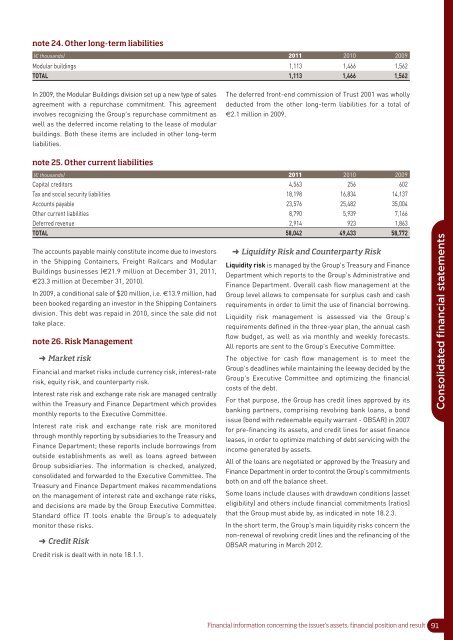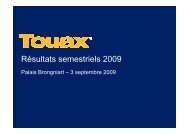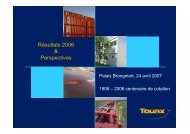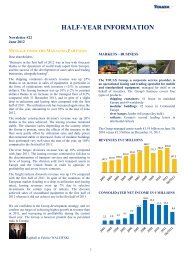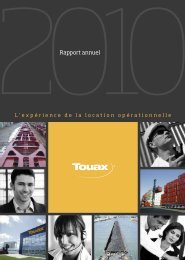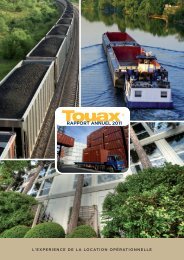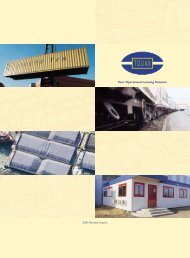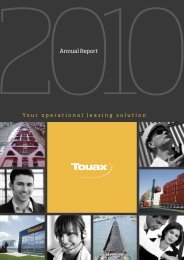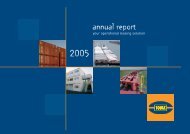2011 Annual report - touax group
2011 Annual report - touax group
2011 Annual report - touax group
Create successful ePaper yourself
Turn your PDF publications into a flip-book with our unique Google optimized e-Paper software.
note 24. Other long-term liabilities<br />
(€ thousands) <strong>2011</strong> 2010 2009<br />
Modular buildings 1,113 1,466 1,562<br />
TOTAL 1,113 1,466 1,562<br />
In 2009, the Modular Buildings division set up a new type of sales<br />
agreement with a repurchase commitment. This agreement<br />
involves recognizing the Group's repurchase commitment as<br />
well as the deferred income relating to the lease of modular<br />
buildings. Both these items are included in other long-term<br />
liabilities.<br />
The deferred front-end commission of Trust 2001 was wholly<br />
deducted from the other long-term liabilities for a total of<br />
€2.1 million in 2009.<br />
note 25. Other current liabilities<br />
(€ thousands) <strong>2011</strong> 2010 2009<br />
Capital creditors 4,563 256 602<br />
Tax and social security liabilities 18,198 16,834 14,137<br />
Accounts payable 23,576 25,482 35,004<br />
Other current liabilities 8,790 5,939 7,166<br />
Deferred revenue 2,914 923 1,863<br />
TOTAL 58,042 49,433 58,772<br />
The accounts payable mainly constitute income due to investors<br />
in the Shipping Containers, Freight Railcars and Modular<br />
Buildings businesses (€21.9 million at December 31, <strong>2011</strong>,<br />
€23.3 million at December 31, 2010).<br />
In 2009, a conditional sale of $20 million, i.e. €13.9 million, had<br />
been booked regarding an investor in the Shipping Containers<br />
division. This debt was repaid in 2010, since the sale did not<br />
take place.<br />
note 26. Risk Management<br />
➜ Market risk<br />
Financial and market risks include currency risk, interest-rate<br />
risk, equity risk, and counterparty risk.<br />
Interest rate risk and exchange rate risk are managed centrally<br />
within the Treasury and Finance Department which provides<br />
monthly <strong>report</strong>s to the Executive Committee.<br />
Interest rate risk and exchange rate risk are monitored<br />
through monthly <strong>report</strong>ing by subsidiaries to the Treasury and<br />
Finance Department; these <strong>report</strong>s include borrowings from<br />
outside establishments as well as loans agreed between<br />
Group subsidiaries. The information is checked, analyzed,<br />
consolidated and forwarded to the Executive Committee. The<br />
Treasury and Finance Department makes recommendations<br />
on the management of interest rate and exchange rate risks,<br />
and decisions are made by the Group Executive Committee.<br />
Standard office IT tools enable the Group’s to adequately<br />
monitor these risks.<br />
➜ Credit Risk<br />
Credit risk is dealt with in note 18.1.1.<br />
➜ Liquidity Risk and Counterparty Risk<br />
Liquidity risk is managed by the Group's Treasury and Finance<br />
Department which <strong>report</strong>s to the Group's Administrative and<br />
Finance Department. Overall cash flow management at the<br />
Group level allows to compensate for surplus cash and cash<br />
requirements in order to limit the use of financial borrowing.<br />
Liquidity risk management is assessed via the Group's<br />
requirements defined in the three-year plan, the annual cash<br />
flow budget, as well as via monthly and weekly forecasts.<br />
All <strong>report</strong>s are sent to the Group's Executive Committee.<br />
The objective for cash flow management is to meet the<br />
Group's deadlines while maintaining the leeway decided by the<br />
Group's Executive Committee and optimizing the financial<br />
costs of the debt.<br />
For that purpose, the Group has credit lines approved by its<br />
banking partners, comprising revolving bank loans, a bond<br />
issue (bond with redeemable equity warrant - OBSAR) in 2007<br />
for pre-financing its assets, and credit lines for asset finance<br />
leases, in order to optimize matching of debt servicing with the<br />
income generated by assets.<br />
All of the loans are negotiated or approved by the Treasury and<br />
Finance Department in order to control the Group's commitments<br />
both on and off the balance sheet.<br />
Some loans include clauses with drawdown conditions (asset<br />
eligibility) and others include financial commitments (ratios)<br />
that the Group must abide by, as indicated in note 18.2.3.<br />
In the short term, the Group's main liquidity risks concern the<br />
non-renewal of revolving credit lines and the refinancing of the<br />
OBSAR maturing in March 2012.<br />
Consolidated financial statements<br />
Financial information concerning the issuer’s assets, financial position and result 91


